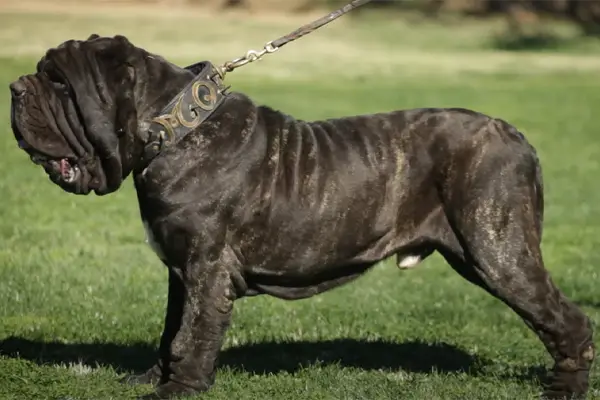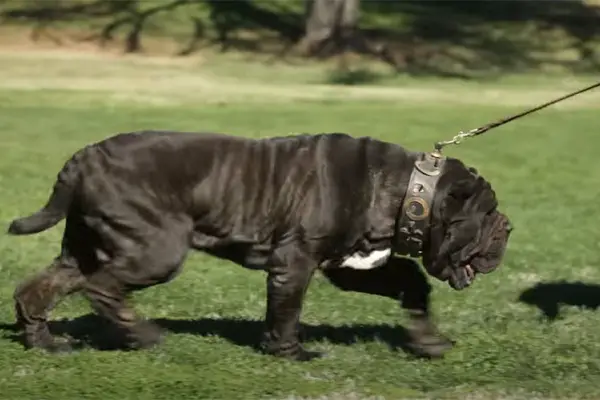Neapolitan Mastiffs are known as majestic and powerful guardian dogs from Italy. Thes Neapolitan Mastiff stands at the height of 31 inches, has a wrinkled face, and loose skin. They can be intimidating to look at, but these dogs make excellent family and companion dogs.
Neapolitan Mastiffs are known as gentle giants. However, they will not be the easiest to live with, especially for inexperienced dog owners. Drools and gas will also be one of your problems, so if you want a neat dog, the Neapolitan Mastiff may not be for you. These dogs may not be suitable for apartment living conditions because of their massive size.
If you’re looking for a unique companion ready to protect, the Neapolitan Mastiff might be for you. That is if you’re willing to do extra work to show him the right love and care.

Neapolitan Mastiff Breed Statistics
| Dog Breed Group | Working |
| Breed Size | Giant |
| Height | 26-31 inches (male); 24-29inches (female) |
| Weight | 150 pounds (male); 110 pounds (female) |
| Lifespan | 7-9 years |
Neapolitan Mastiff Breed Ratings
| Energy level | |
| Exercise needs | |
| Requires attention | |
| Playfulness | |
| Trainability | |
| Shedding | |
| Grooming | |
| Friendly with family | |
| Friendly with kids | |
| Friendly with strangers | |
| Friendly with other dogs | |
| Prey Drive |
Neapolitan Mastiff History
The history of Neapolitan Mastiffs can be traced back to Naples, Southern Italy. They are believed to have descended Roman war dogs and British mastiffs. The breeders’ goal was to create a dog of giant size who would serve to protect them but are, at the same time, loyal and loving towards their family.
For years, these dogs remained in Italy until 1946 when they were brought to a Naples dog show. A journalist, Piere Scanziana, saw the breed as a descendant of the Roman Empire. So, he worked the hardest to make it known in other countries.
He started by creating the breed standard, and three years later, the breed was finally recognized by the international dog registry. It was in the early 1970s when the breed became famous all over Europe. Around 1973, the first of the breed was imported to the US.
In the same year, the Neapolitan Mastiff Club of America was formed. However, it took several years before the American Kennel Club recognized the dog breed in 2004. Now, Neapolitan Mastiffs rank 102nd as the most popular dog breed in the US today.
Neapolitan Mastiff Temperament
Neapolitan Mastiffs are best described as loyal, dignified, and watchful dogs. They are usually calm, quiet, and relaxed when indoors, but expect that when the need arises, he becomes a great protector.
Though loving and affectionate towards family members, Neapolitan Mastiffs are suspicious towards strangers. They will not attack unless necessary, but they will stand guard until he knows everything is alright.
They are also known to be possessive, especially with one person he becomes attached to. Thus, it’s not recommended to leave this dog alone for long periods as he tends to get separation anxiety.
Neapolitan Mastiffs will make great companions for older children who already know how to behave. Toddlers, however, need supervision as the giant size of this dog may cause accidents. They are also good with pets that grew up with them. But dog aggression may be a problem for stray dogs, especially if of the same sex.
Early socialization will help a Neo become more well-rounded dogs. This will also help keep the aggression at bay as he gets accustomed to new sights, sounds, people, and animals.
Training should be done at an early age, and it should be firm and consistent. You should be confident and let him know that you are the one he needs to follow.

Neapolitan Mastiff Care Requirements
- Nutrition: Neapolitan Mastiffs require a high-quality and well-balanced meal to help support his daily energy needs. No special diet is needed as long as it contains all the essential nutrients – proteins, fats, carbohydrates, vitamins, and minerals. When you’re buying food for your Neo, make sure only to buy high-quality ingredient sources. If you plan to feed him dog food, choose the premium quality ones free from fillers and additives that may be harmful. You can also ask your vet for recommendations on the best meal plan for your dog. Ask advice regarding the number of calories to feed your dog, too, so that you won’t have to worry about getting them overweight.
- Grooming: Neapolitan Mastiffs are short-coated dogs that shed seasonally. They require only weekly brushing, possibly daily, if the shedding season comes. Baths can occasionally be given too, or as needed, depending on how dirty or smelly he gets. If you’re not bathing him, make sure to regularly check up the folds of his skin and clean it out. It should be free of dirt and debris, which can cause skin disease. Keep a towel with you always and be ready to clean up the drool from his face. Make sure to check and clean the ears regularly to avoid ear infection. Nails should be kept short, so your dog remains comfortable always.
- Exercise: Neos are sometimes content to lie indoors. However, as much as they love it, you shouldn’t allow it. These dogs require regular exercise to keep their bones and joints healthy. As puppies, you can expect them to enjoy running around your yard and play. However, as they get bigger, you may need to take him out to daily walks and on-leash instead. Always assist him when going up and down the stairs as he might get injured.
- Health: Neapolitan Mastiffs have a short lifespan; however, with the right care given, you might still be able to prolong this. This is why it’s essential to note what health conditions your Neo is prone to so you may prevent it. Bone conditions such as hip dysplasia and elbow dysplasia are very common to dogs this size, so it’s essential to give them enough exercise. Skin disease such as fold dermatitis is also common because of the wrinkles in the skin. Cardiomyopathy, cherry eye, cleft palate, and demodicosis are also common to the dog breed. For diseases that are genetically transferred, it’s best to meet at least one of your dog’s parents to know if your dog may inherit such disease. Try to find out symptoms of these conditions, so you know if there is any change in your dog’s behavior. If so, take him immediately to the vet for a check-up.
- Lifespan: The life expectancy of Neapolitan Mastiffs is 7-9 years.
Famous Neapolitan Mastiffs
- Samson: One of the biggest and heaviest Neapolitan Mastiffs in history; one the first Best in Show
- Fang: The Neapolitan Mastiff of Hagrid in Harry Potter
- Alan: The Neapolitan Mastiff from the film Babe
- Pansy: Andrew Vachss’ Neapolitan Mastiff
- Bella: Kate Hudson’s Neo
Fun Facts about Neapolitan Mastiffs
- Neapolitan Mastiffs are ancient dogs from Naples, Italy, hence its name.
- These dogs were developed to be guard dogs, fighting dogs, and hunting dogs.
- They were called by many other names – Neo, Mastino Napoletano, Italian Molosso, and Mastino.
- They are believed to be descendants of the Molossian Hound.
- The wrinkles on their face served a purpose: to protect them when an enemy attacks them.
- Their coat comes in various colors: grey, blue, black, brown, and brindle.
- They are not tolerant of heat and cold.
- They were recognized by the American Kennel Club in 2004.
